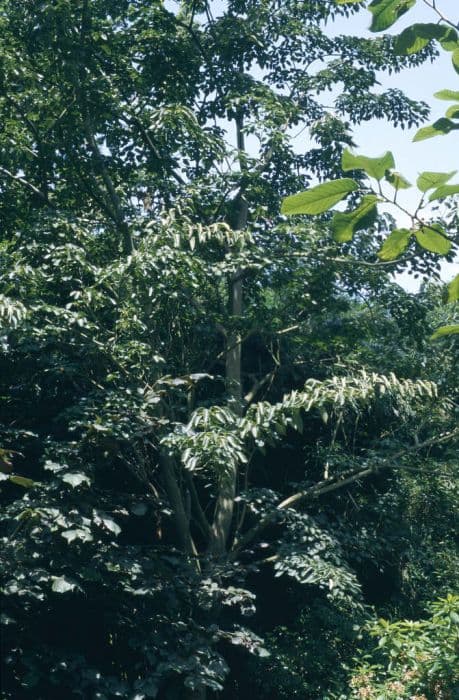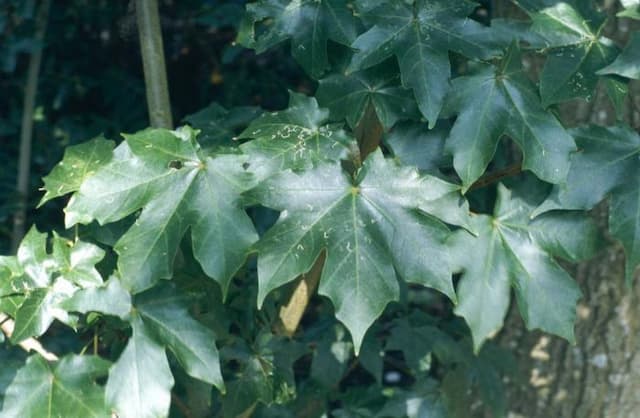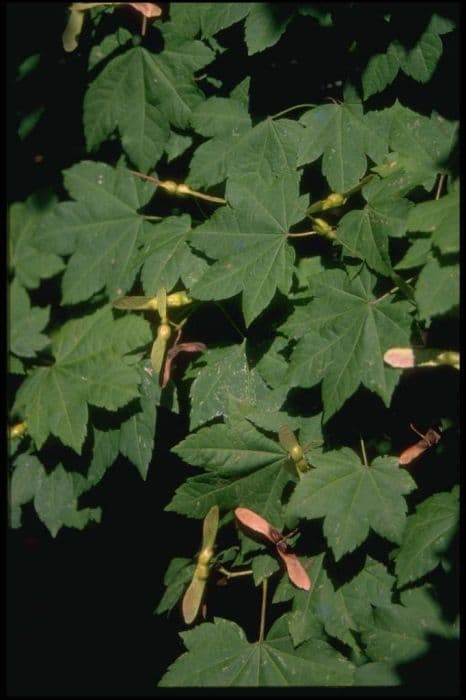Japanese Maple Acer palmatum var. heptalobum

ABOUT
Acer palmatum var. heptalobum, commonly known as the Japanese maple, showcases a beautiful and highly ornamental appearance that makes it a favorite in gardens and landscapes. Its leaves are a distinctive feature, typically having seven lobes (as hinted by its name, with "hepta" suggesting seven), and they radiate outwards in a palmate fashion, resembling the shape of a hand with outstretched fingers. In the spring, the foliage emerges with a fresh, vibrant hue, shifting colors as the seasons advance. Depending on the cultivar, the leaves can exhibit a variety of colors, ranging from deep purples to bright greens, with some showcasing stunning shades of red or orange. Often the leaves will change hues with the passing of the seasons, providing a display that evolves throughout the year. Fall is a particularly striking time for the Japanese maple, as the leaves put on a fiery show of autumnal tints, transforming the plant into a focal point of the landscape. The texture of the leaves is another appealing attribute, with some exhibiting a delicate, lace-like appearance, while others may be more robust and deeply cut. The branching structure of the Japanese maple is elegant and often architecturally interesting, with branches that sweep and twist, creating a visual spectacle even in the winter months when the tree is devoid of leaves. Its bark, too, adds to its ornamental value, with colors that can vary from a subtle gray to shades of brown, sometimes exhibiting a slightly rough texture. The overall appearance of the Japanese maple is one of refined grace and exotic beauty, contributing a touch of Eastern allure to the environment where it is planted. The interplay of its leaf shapes, colors, and its intricate branching make it a beloved and striking specimen in any setting where the focus on ornamental qualities is desired.
About this plant
 Names
NamesFamily
Sapindaceae
Synonyms
Japanese Maple, Smooth Japanese Maple
Common names
Acer palmatum var. heptalobum.
 Toxicity
ToxicityTo humans
The most common name for Acer palmatum var. heptalobum is Japanese Maple. Generally, Japanese Maple is not considered toxic to humans. There are no well-documented cases of poisoning from ingesting parts of this plant. Therefore, accidental ingestion is unlikely to cause harm, but as with any non-food plant, it is advisable to avoid consumption.
To pets
Japanese Maple, which is another name for Acer palmatum var. heptalobum, is also not typically considered toxic to pets. There is limited information on the plant causing significant health issues in pets following ingestion. However, it is always best to prevent pets from chewing on non-edible plants to avoid any potential risks or gastrointestinal irritation.
 Characteristics
CharacteristicsLife cycle
Perennials
Foliage type
Deciduous
Color of leaves
Varies
Height
15-25 feet (4.5-7.6 meters)
Spread
10-25 feet (3-7.6 meters)
Plant type
Tree
Hardiness zones
5-8
Native area
Japan
Benefits
 General Benefits
General Benefits- Aesthetic Appeal: The Japanese Maple offers stunning foliage color changes across the seasons, from vibrant greens to fiery reds and purples, enhancing the visual appeal of gardens and landscapes.
- Shade Tolerance: It can thrive in areas with partial shade, making it a versatile choice for gardeners dealing with varied lighting conditions.
- Compact Size: Its relatively small stature makes it suitable for gardens with limited space or for container gardening.
- Seasonal Interest: With its changing leaf colors and attractive bark, the Japanese Maple provides year-round visual interest.
- Wildlife Support: The tree can serve as a habitat and food source for various wildlife, including birds and beneficial insects.
- Low Maintenance: Once established, it generally requires minimal care, making it a good option for both novice and experienced gardeners.
- Cultural Significance: Often associated with peace and tranquility, it's a popular element in traditional Japanese garden design, adding a sense of Zen to the landscape.
 Medical Properties
Medical PropertiesThis plant is not used for medical purposes.
 Air-purifying Qualities
Air-purifying QualitiesThis plant is not specifically known for air purifying qualities.
 Other Uses
Other Uses- Acer palmatum var. heptalobum, commonly known as Japanese Maple, can be used in bonsai cultivation due to its ability to accept pruning and its naturally beautiful structure.
- The wood of Japanese Maples can be used in the creation of musical instruments, such as flutes, due to its fine grain and workability.
- The sap from Japanese Maple trees can be used to make a type of syrup, similar to that of sugar maples, albeit less common and more labor-intensive to produce.
- The foliage of Japanese Maples provides a natural mulch as it decomposes, enriching the soil with nutrients important for garden ecology.
- Japanese Maple branches can be used in floral arrangements, especially during autumn, when the leaves exhibit vibrant colors.
- The fallen leaves of Japanese Maple trees can be used in art projects or pressed leaf crafts due to their intricate shapes and stunning autumn hues.
- Japanese Maple trees can be planted to create garden focal points or visual screens, offering privacy and enhancing landscapes with their aesthetic appeal.
- During winter, when the leaves have fallen, the silhouette of Japanese Maple branches can provide stark architectural beauty in a snowy landscape.
- The bark of mature Japanese Maples, which flakes and creates patterns, can be used visually in garden design to add texture and year-round interest.
- Fine woodworking and cabinetry can also benefit from using the dense wood of Japanese Maple for decorative inlays and delicate furniture accents.
Interesting Facts
 Feng Shui
Feng ShuiThe Japanese Maple is not used in Feng Shui practice.
 Zodiac Sign Compitability
Zodiac Sign CompitabilityThe Japanese Maple is not used in astrology practice.
 Plant Symbolism
Plant Symbolism- Beauty: The Japanese Maple is often associated with beauty due to its delicate leaves and vibrant color changes with the seasons.
- Change: The tree's changing leaf color from green to bright reds, oranges, or purples symbolizes the change and impermanence in life.
- Peace: The Japanese Maple's serene growth habit and graceful shape evoke a sense of peace and tranquility.
- Balance: This tree is often used in Japanese gardens, where it represents balance and harmony within the landscape.
- Endurance: Despite its delicate appearance, the Japanese Maple can live for many years, symbolizing endurance and strength.
 Water
WaterJapanese Maple should be watered deeply once or twice a week, depending on the weather conditions and soil drainage. Aim to keep the soil consistently moist but not waterlogged. During the growing season, you may need to water several gallons per plant, especially if the weather is particularly dry or hot. Reduce watering in the fall to prepare the tree for winter. During drought conditions, ensure the tree receives at least 1-2 gallons of water per week.
 Light
LightJapanese Maple prefers a spot with dappled shade or morning sun and afternoon shade. It can tolerate full sun, but the leaves may scorch in hot afternoon sun, especially in southern climates. Placing it in a location that mimics the light conditions of a forest understory is ideal for this variant of Japanese Maple.
 Temperature
TemperatureJapanese Maple does best in a temperature range of 60°F to 80°F but can survive winter temperatures down to -20°F. It's less tolerant of high heat, with leaf scorch occurring if temperatures exceed 90°F for extended periods. The ideal growing conditions mimic its native cool, temperate environment.
 Pruning
PruningPrune Japanese Maple in late fall or winter to shape the tree and remove any dead or crossed branches. Pruning while the tree is dormant minimizes sap loss and allows for easier identification of the tree's structure. Pruning every 2-3 years is generally sufficient, focusing on maintaining the tree's natural form.
 Cleaning
CleaningAs needed
 Soil
SoilJapanese Maple thrives in well-draining, moisture-retentive soil with high organic matter; aim for a pH of 5.5 to 6.5. A good mix is one part peat moss, one part pine bark, and one part coarse sand or perlite.
 Repotting
RepottingJapanese Maple should be repotted every 2-3 years during dormancy in late winter or early spring to replenish nutrients and facilitate healthy growth.
 Humidity & Misting
Humidity & MistingJapanese Maple prefers moderate humidity but is adaptable; a range of 40-60% is generally satisfactory for healthy growth.
 Suitable locations
Suitable locationsIndoor
Place Japanese Maple in a bright spot with indirect light, avoid dry air.
Outdoor
Plant it in dappled shade, shelter it from intense sun and winds.
Hardiness zone
5-9 USDA
 Life cycle
Life cycleAcer palmatum var. heptalobum, commonly known as Japanese maple, begins its life cycle when seeds sown in well-draining soil germinate, typically requiring stratification to break dormancy. Seedlings emerge with a set of starter leaves (cotyledons) before developing true leaves that are characteristically lobed and palmate. As the sapling matures, it establishes a strong root system and a distinctive, often gracefully-shaped branching pattern. Over several years, the tree reaches maturity, featuring a display of seasonally changing foliage that ranges from vibrant greens in spring and summer to fiery reds and oranges in fall. The Japanese maple produces small, inconspicuous flowers in spring, followed by winged samaras (seed pods) that disperse in the wind enabling the spread of seeds. With proper care, including adequate water, mulching, and protection from harsh conditions, Acer palmatum var. heptalobum can live for decades, often surpassing a century in longevity.
 Propogation
PropogationPropogation time
Early Spring
The Japanese Maple, known botanically as Acer palmatum var. heptalobum, is commonly propagated through seed, cuttings, grafting, or layering. The most popular method is through grafting, where a section of a stem with leaf buds is inserted into the stock of another tree. Grafting is typically performed in late winter before the sap starts to flow. The scion, which is the piece of the donor plant, is carefully selected for its attributes and must be compatible with the rootstock, which provides the root system. To graft, a clean, slanting cut is made on both the scion and the rootstock, and they are joined together, aligning the cambium layers. The graft is then wrapped with grafting tape and sealed with grafting wax to maintain moisture and encourage the tissues to fuse. If successful, the grafted union will grow into a new Japanese Maple tree with the characteristics of the scion plant.








